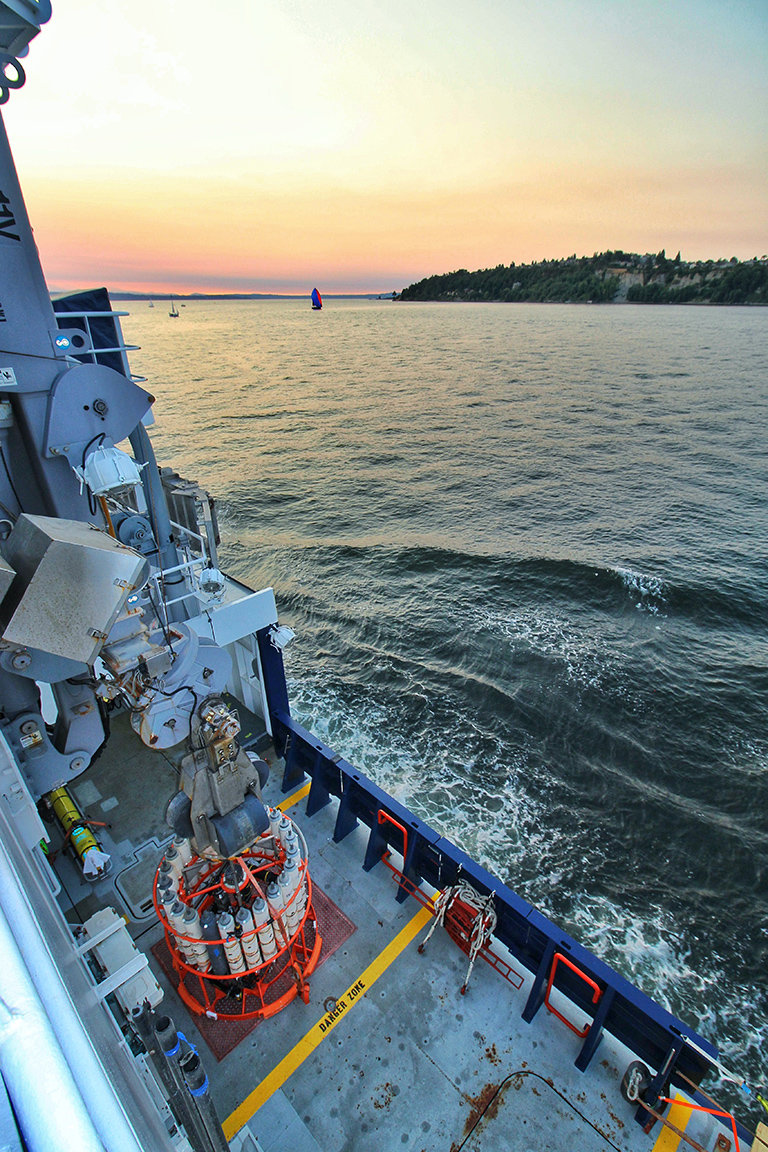Ask NASA Climate | September 24, 2018, 14:01 PDT
Oh, the places we'll go: Tales from a traveling scientist

Golden hour looks good on the CTD, too! Credit: Alex Niebergall
Alex Niebergall is a PhD student in Earth and Ocean Sciences at Duke University and worked aboard the R/V Sally Ride in the North Pacific in August and September.
Before I joined the science crew aboard the R/V Sally Ride and set sail for the middle of the Pacific Ocean for my first ever research cruise, I can honestly say I did not know what to expect. Would it be an adventure? I hoped so. Would it be long hours in the lab? Undoubtedly. Would it be like stepping into National Talk-Like-A-Pirate-Day for an entire month? Maybe not. What I did know is that the research cruise meant 34 days on the open ocean doing what I love, and that was the only enticement I needed to sign up!
For me, it has always been about the ocean. Don’t get me wrong, I love science. I know this because my time as a researcher has taken me to far more windowless labs in the basements of old science buildings than remote, dream-like field locations, and I have enjoyed every second of this work too! But even this windowless basement science ties back to Earth, the environment, and most importantly (in my eyes) the ocean. Throughout elementary and high school, I was drawn to science and math because they gave me new ways to look at the world around me. Suddenly, every baseball game was a math problem—the velocity of the pitch, the angle of impact, the parabolic motion of the ball as it headed into the outfield (why, no… I’ve never been very good at sports, how did you guess?).
As an avid outdoorswoman, I've found science unlocking even more secrets. Physics and geology courses taught me about wave motion and erosion. Biology, ecology, genetics, and evolution classes allowed me to go to tide pooling and appreciate the radial symmetry of an ochre sea star while understanding its predatory role in the intertidal ecosystem. A firm grasp of chemistry allowed me to look at the ocean on a much smaller scale—a system of salinity gradients, dissolved nutrients, and pH balance. (Not to mention that chemistry makes cooking more interesting!) These subjects were interesting because I saw them every day around me, connected and continuously in flux, influencing each other in every way and giving me a new appreciation for all the activities and places I already loved.
Oh, the places we’ll go…
In truth, science has taken me to some of the coolest places I could possibly imagine. As an undergrad, I went to field sites in the depths of the Northern California wilderness that look so wild and untouched they could be the set for the next Jurassic Park movie. I’ve been to redwood forests studying ecosystem dynamics. Science training took me to the underwater kelp jungles of Monterey Bay, California, and offshore Oregon where I learned, among other things, that measuring baby sea stars (sometimes the size of my thumb nail) becomes infinitely more challenging in a surge that forces you 8 feet in either direction. I also learned that sea creatures (specifically sea otters and trigger fish) have the ability and the instinct to irreparably damage science equipment, but THAT is a story for another time! Research took me to the underwater paradise that is the coral reefs of Indonesia, where night diving with bioluminescent dinoflagellates meant that the water around me perfectly mirrored the stars that sparkled out of the darkness overhead.
Now as a brand new graduate student in Earth and ocean science, I found myself living on a floating laboratory in the middle of the Pacific Ocean, with a view of the waves as far as the eye can see in a blue hue that is unlike anything I ever saw in my life. My group’s project aboard the ship was focused on quantifying how the plankton communities in the ocean influence carbon export by estimating the net community production at the ocean’s surface. We did this by measuring biological oxygen concentrations in the surface water and pairing these data with genetic analyses of the microbial community. These measurements allowed us to infer how much carbon was being taken up by biological processes and, thus, taken out of the atmosphere.
With this project, those same subjects I learned to love in the tenth grade—chemistry, ecology, genetics, math—tied together (with the help and expertise of many, many other dedicated scientists) to give us a comprehensive view of what is happening in the ocean and how it affects our planet’s climate.
To some, the idea of being a floating speck in the middle of the ocean may seem isolating (or at the very least, nausea-inducing). To me, it is the coolest place I’ve ever been. The view reminds me that I am a small part of something big, not just as a junior scientist in the immense scientific undertaking that is the EXPORTS project, but also as one small human in the middle of an enormous planet that we have the privilege to explore, admire, question, and hopefully understand. Today, I am a happy, and very lucky, scientist because I was on this wild adventure, working alongside some of the most inspirational and dedicated scientists I have ever met.
But tomorrow? Tomorrow I am eagerly waiting to see where science will take me next.
This piece was originally published on NASA's Earth Expeditions blog.
